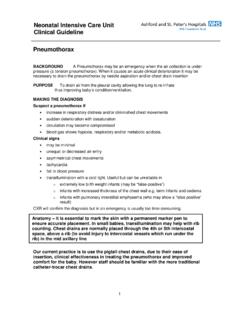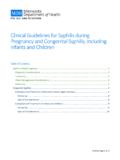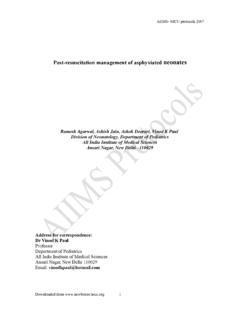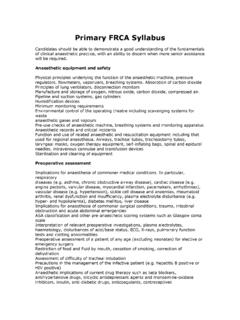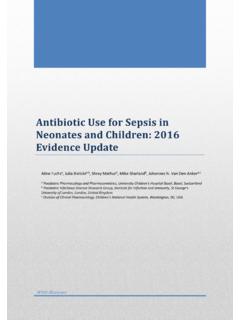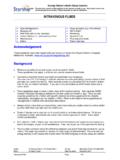Transcription of Neonatal Intensive Care Unit Clinical Guideline …
1 Neonatal Intensive care unit Clinical Guideline Incubator Humidity for Premature neonates Introduction neonates below 30 weeks gestation have an underdeveloped epidermis and stratum corneum (which controls evaporative heat loss and transepidermal water loss (TEWL)). They are at increased risk of high water loss through the skin, leading to temperature instability, dehydration and electrolyte imbalance, as well as heat and calorie loss. Increasing humidity to the surrounding environment can significantly reduce these from occurring. After birth the skin of preterm babies is exposed to a gaseous environment and matures rapidly, both in its epidermal structure and its barrier function (Agren et al, 2006). By about 2 weeks after birth (regardless of gestation) the neonate's skin functions like that of a term baby (RPAH, 2001).
2 Environmental humidification (EH) is able to reduce TEWL and assist with temperature regulation. However, nursing babies in EH has also been shown to slow the natural process of epidermal barrier formation or skin adaptation' to the external environment. We need to balance the infants' need for heat and humidity with the adaptive benefits of a drier environment for stimulating epidermal DNA synthesis. Many different guidelines exist, this Guideline is based on the common threads of those listed in the references. The reasons for the variation in guidelines is not clear but is likely to reflect personal practices rather than strict evidence. Assessment All infants below 30 weeks gestation admitted to NICU, and below 2 weeks of age, should be commenced in humidity as soon as possible.
3 Clothing or woollen blankets are not needed. Management Babies less than 28 weeks gestation Commence 80% incubator humidity Continue for 7 days After 7 days, wean by 5% each day Cease incubator humidity when 40% is reached Babies 28 29+6 weeks gestation Commence 80% incubator humidity. After 1 day wean humidity by 5% each day. Cease incubator humidity when 40% is reached Commence humidity as soon after admission as possible. Do not delay unless absolutely necessary ( an urgent procedure). Extremely preterm babies (<25 weeks) may require humidification for longer if there are problems with dehydration / hypernatraemia, but most will not. Incubator temperature may need to be increased when the humidity is decreased to ensure thermal stability for the baby. There are concerns that prolonged humidification may increase the risks of sepsis, so prolonged humidification should not be routine and should be reviewed regularly.
4 Use sterile water only, to prevent colonisation by bacteria, check regularly especially on high humidity (incubator will alarm if water levels low). It is not necessary to keep the humidity on in the Drager incubators. Empty the water tank when the humidity is turned off. Change incubators weekly. Environmental Humidification Page 1 of 2 27/01/2014. References / Reading 1. Agren, J., Sjors, G. & Sedin, G. (1998). Transepidermal Water Loss in Infants born at 24 and 25. Weeks of Gestation. Acta Paediatrica, 87, 1185-1190. 2. Agren, J., Sjors, G. & Sedin, G. (2006). Ambient Humidity Influences the Rate of Skin Barrier Maturation in Extremely Preterm Infants. The Journal of Paediatric. May, 613-617. 3. Allwood, M. (2011). Skin care guidelines for infants aged 23-30 weeks' gestation: a review of the literature.
5 Neonatal , Paediatric and Child Health Nursing. 14(1),20-27. 4. Beath C. (2011). Humidified Incubator in NICU. Kaleidoscope - The Children's Health Network. Clinical Guideline from Neonatal Intensive care unit John Hunter Children's Hospital. 5. Eastern Region Neonatal Benchmarking Group. (2008). Humidity for infants < 30 gestation. Guideline . 6. Modi, N. (2004). Management of Fluid Balance in the Very immature Neonate. Archives of Disease in Childhood. 89, F108-F111. 7. Fanaroff, Fanaroff, (2013). Klaus & Fanaroff's care of the High-Risk Neonate. 6th Edition. Elsevier Saunders. Philadelphia. 8. Flenady, V. & Woodgate, (2009). Radiant warmers versus incubators for regulationg body temperature in newborn infants (Review). The Cochrane Collaboration. Wiley Publishers.
6 9. Modi, N. (2004). Management of fluid balance in the very immature neonate. Archives of Diseases in Children Fetal Neonatal Edition. 89, F108-F111. 10. PICU Neonatal Group. (2005). Temperature Control in the Preterm Neonate. Newborn Clinical Guideline from Birmingham Children's Hospital. 11. Royal Children's Hospital, Melbourne, Australia - Clinical Guideline 12. Sinclair, L., Crisp, J. & Sinn, J. (2009). Variability in incubator humidity practices in the management of preterm infants. Journal of Paediatrics and Child Health. 45, 535-540. 13. Sinclair, L. & Sinn, (2009). Higher Versus Lower Humidity for the Prevention of Morbidity and Mortality in Preterm Infants in Incubators. The Cochrane Library. 14. Smith J. (2010). Small Baby Guideline - Management of infants < 27 weeks gestation.
7 Newborn care Guideline from Royal Prince Alfred Hospital. 15. South Central Neonatal Network Clinical Guideline 16. 17. mature_Neonates/. 18. CC8 QFjAA&url=http%3A%2F% g-1%2 FSKINCARE%2520benchmark% V7 AbYwIDYDA&usg=AFQjCNGwfpjaB5To6W5 XEovQuQFhoYuitw&bvm= , Guideline prepared by Dr. Peter Reynolds with advice from senior nursing staff December 2013. Approved with changes from CMG Jan 2014. Review Jan 2017. Environmental Humidification Page 2 of 2 27/01/2014.




